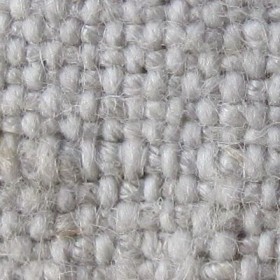– what whiteworkers should consider when buying
My article “Linen: Embroidery Fabric from Flax Fibres” garnered such positive responses that I now want to share some information about old, handwoven “Bauernleinen”.
In Germany and the surrounding countries, a relatively great number of old, handwoven linen is offered for sale by private persons via advertisements, by antique traders, at flea markets and of course on Ebay. Because most of these linen rolls were produced on farms, or for farmers, and stored there in coffers for many decades, they are also called “Bauernleinen” (farmer linen).
To show the wide range of offers, here are just two links with the search terms “Bauernleinen Ballen” and “Bauernleinen Rolle” (should the links below not work, simply type these terms into your search engine):
http://www.ebay.de/sch/i.html?_nkw=bauernleinen+ballen
http://www.ebay.de/sch/i.html?_nkw=bauernleinen+rolle
Nothing is more beautiful than a Schwalm-typical embroidery with traditional designs and filling patterns worked on old, handwoven linen.
Handwoven linen is rarely found in a width greater than 80 cm. Most of this old, handwoven linen is between 60 cm and 75 cm wide. If one wants to work a wider project, one must sew together the linen strips along the selvage.
Not all old, handwoven linen is suitable for embroidery. There are different reasons:
- before production, the linen was predetermined to be used for coarser applications
- the linen was not properly stored to survive in pristine condition over the years
- the linen is too unevenly woven for this type of embroidery
While researching my first linen article I found an interesting graphic. Although it originates from the year 1984, and in the interim flax plants have been cultivated to bring about more oil or more fiber products, still the graphic is valid today to show the process of refining flax.
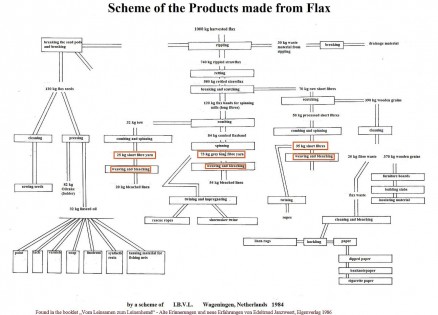
Interesting for embroiderers are the orange marked boxes. Here one can see that after retting and also after combing, short fibers are accumulated. Short fibers are, as well as long fibers, woven into linen fabric. Such linen fabrics are used for coarser bags and for wagon cloths and other coarse items.
Only the linen fabric made of long fibers are suitable for embroidery. These fabrics have a more even and smooth look.
Withdrawing the threads of short-fiber linen is very difficult; the short fibers do not run the length or width of the cloth. The fabric threads pull apart or disintegrate and the fibers are felted.
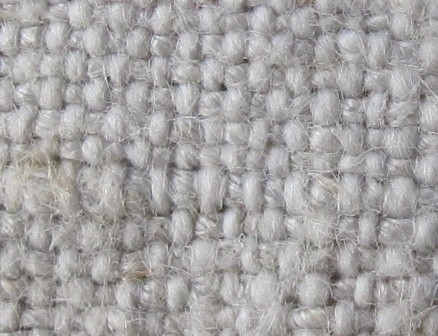
Handwoven linen is almost always densely woven. One has to look for a fabric with a linen weave (there are also linen fabrics with a twill weave which is not suitable for Schwalm embroidery). The fabric should have a thread count between 14 cm and 20 cm; the same or approximately the same count in both directions (warp and woof).
The linen should have as few stains as possible—rust spots and spots of mold are not removable (surface dirt is not a problem and can be removed during final laundering).
If you can buy linen in person, please take notice of its feel which should be nice and not scratchy. Define the thread count. Hold the linen against the light to see if there are obvious thin areas. Ascertain that there are no spots. If, after careful inspection, you think the linen is good, ask the seller to allow you to withdraw a thread at the edge.
If you can buy linen only through pictures and descriptions, take meticulous care that the pictures are clear and the details are magnified. Threads can be counted with pictures (one a very clear, allover view, and one a detail picture—best with a coin placed on the fabric). Usually only a picture with the whole roll is shown, and this is not very useful.
If the pictures show what you want to see, and the description of the item is right, one can take a leap of faith and buy the linen—it’s a leap of faith that the linen will be worthy of your embroidery efforts. One can ascertain the true quality of the linen only when the linen is held in hand and closely inspected.
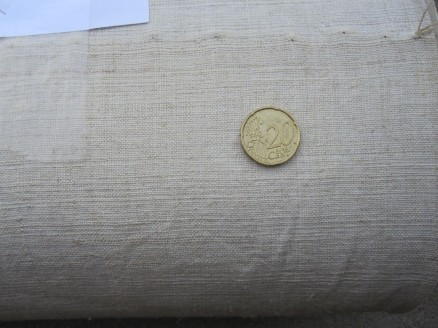 The linen shows, at the first sight, an uneven structure. The enlargement clearly confirms that the linen is woven very unevenly.
The linen shows, at the first sight, an uneven structure. The enlargement clearly confirms that the linen is woven very unevenly.
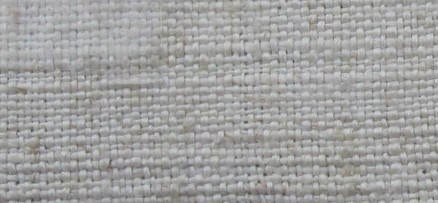 I would not buy this linen for embroidery.
I would not buy this linen for embroidery.
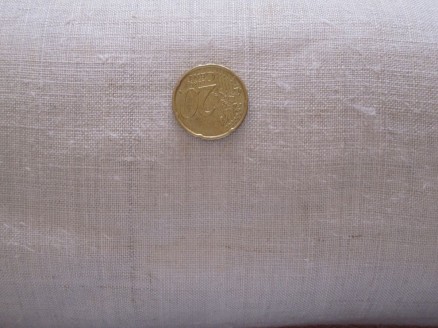
This linen has a smooth appearance. The enlargement shows the even weave. The description of the item read: “white, very fine, smooth linen (see pictures); 73 cm width. The linen was not used so far, it is unwashed and in a good original condition, clean and without damages. It is jet natural gray and will become snow white after laundering. It comes from a farm in „Niedersachsen“.
This fine Quality was at the time used for clothes, for shirts, sheets and others.“
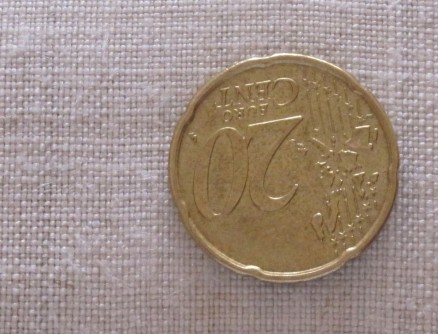 For this linen, I would take a leap of faith and buy it for embroidering.
For this linen, I would take a leap of faith and buy it for embroidering.
If the pictures are unsatisfactory and the seller is not willing to send better ones, one should absolutely resist buying the linen.
